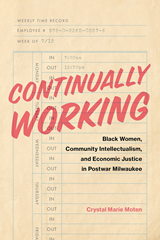Continually Working: Black Women, Community Intellectualism, and Economic Justice in Postwar Milwaukee
March 02, 2023
Crystal Marie Moten’s Continually Working is an excellent addition to our historic records and a much-needed honoring of Black women.
 Continually Working: Black Women, Community Intellectualism, and Economic Justice in Postwar Milwaukee by Crystal Marie Moten, Vanderbilt University Press
Continually Working: Black Women, Community Intellectualism, and Economic Justice in Postwar Milwaukee by Crystal Marie Moten, Vanderbilt University Press
Earlier this year, the Florida Department of Education rejected the College Board’s new Advanced Placement African American Studies course, alleging that the curriculum pushed a political agenda meant to “indoctrinate” students. Florida’s Education Commissioner tweeted out a graphic listing the department’s concerns with the curriculum, highlighting units on Black feminism, the Black Lives Matter movement, Black queer studies, and reparations. Among these concerns, he specifically called out works by a number of Black female writers and Black queer writers, including Kimberlé Crenshaw, Angela Davis, Roderick Ferguson, Leslie Kay Jones, bell hooks, and Robin D.G. Kelley. These attacks have made clear that while the inclusion of African American and Black history in K-12 history classes is already fraught, even more vulnerable is the history of Black women and queer folk.
A history that does not represent the actions and perspectives of all involved is an incomplete history, and not knowing our history allows systems of oppression to run unchecked. We need to know what our antecedents did before us so that we can build toward a better future. Most importantly, we need to ensure that the reality around us matches with what is preserved in our history. This is the thread that runs through historian Dr. Crystal Marie Moten’s new book, Continually Working.
In the book’s prologue, Moten reminisces on the Black women who influenced and shaped her early life, from her family members to her church pastor to her educators from elementary school through college, all of whom exemplified active leadership and community-building at the heart of their work. Yet when she arrives at graduate school to study history, Moten notes a disconnect between the activism and leadership she has grown up around and a distinct lack of these narratives across history. It wasn’t until her final year of undergraduate education that, by taking classes with historian Dr. Leslie Brown, she encountered works by Black feminist intellectuals. “I entered graduate school,” Moten writes, “with questions that I needed to answer to reconcile my personal witness with what I saw as missing in the historiographical record.”
Geographically, historians have focused on Black narratives from the South. When the North or Midwest have been discussed, the emphasis has been primarily on Chicago and Detroit, leaving out areas like Milwaukee despite the city having a sizeable Black population. Within those narratives, the presence of Black women was minimal, to the point that Moten believed these historical records had to be difficult to find, else they would have been included. Moten writes (emphasis mine):
I entered the archives expecting to have to dig and dig to find extant traces of Black women’s actions. However, what I encountered was the exact opposite—in every collection I explored, I tripped and stumbled over Black women’s work. They were all over the twentieth century record. In some collections so apparent were their actions that I could only come to one conclusion: these women, their efforts, and their work had been intentionally excised, erased, deleted, discarded, and analyzed out of the story.
Her book thus rebuilds the overlooked history of Black women activists and community leaders in Milwaukee as they organized for equal employment and thriving communities from the 1940s to the 1970s.
In Chapter 1, readers learn about Nana Baker, Jeanne Hopkins, and Bernice Lindsay, staffers at the Milwaukee Young Women’s Christian Association (MYWCA) to build safe community spaces for Black working women, only to have their resources diminished and be pushed out of their positions by a majority-white Board of Directors and leadership. Chapter 2 focuses on the efforts of Mattie DeWese, founder of the Pressley School of Beauty Culture, and Black beauticians like Mary Evelyn Williams and Willie M. Mitchell who fought to legitimize their work while confronting the bureaucracy of the Wisconsin State Board of Health. Chapter 3 focuses on the struggles by Black women to attain stable, high paying jobs amid the Jim Crow job system that favored white and male workers over Black women workers, as well as the efforts of community leaders such as Milwaukee NAACP president Ardie Halyard to advocate for women workers and keep a historic record of their grievances. Chapter 4 focuses on activists such as Gertrude Strean, Clementina Castro, and Cassie Downer, mothers who founded the Milwaukee County Welfare Rights Organization to lobby their elected officials when policies and budget cuts threatened the health and safety of their children. Finally, Chapter 5 tells the story of Project Equality Wisconsin, led by Helen Barnhill, which helped local businesses comply with equal employment opportunity laws, and of the National Interreligious Commission on Civil Rights, led by Betty Thompson, which sought to uphold civil rights policies at a time when the federal Commission on Civil Rights was becoming overly politicized.
Moten’s search for these stories stemmed from the need to reconcile what she knew to be true about Black women’s activism with its absence in the history books. In reading this, I thought about the Black women activists and leaders that I’ve been lucky to know and witness here in Milwaukee. There’s Angela Lang and her staff at Black Leaders Organizing for Communities (BLOC) who have trained waves of new community organizers to increase Black voter turnout across Milwaukee. There’s Dr. Cassandra Bowers, president of the African American Roundtable, whose team has organized to divert excessive city funding for police towards affordable housing programs and social services instead. There’s Solana Patterson-Ramos, the director of community outreach at MKE Black working to elevate Black businesses and cultural events across the city. There’s Maxine Webb, whose work as the development director for the ACLU of Wisconsin led to a highly visible partnership with the Milwaukee Bucks to increase voter engagement. I could keep going—the point here is that there are countless Black women in the field right now working to make Milwaukee a better place for all. In the conclusion of her book, Moten also includes the contemporary work of activist Sharon Adams of the Walnut Way Conservation Corporation and artists Lilo Allen and Tiffany Miller of the Bronzeville Collective MKE to highlight the continuing work of Black women fighting for economic justice.
Black history and Black activism are not insular. The achievements of Black women organizers elevate the quality of life not just for Black communities, but for the whole of the city. Negating the place of Black women in our collective narrative not only erases fundamental pieces of our national history but creates an alternate, false narrative in which others can take credit for their work—or worse, can cause us to believe that there is nothing that can be done in the face of structural oppression. The events surrounding the AP African American Studies program should not be ignored. This doesn’t simply affect high school students and their educators—the erasure of Black women’s history is a far broader societal injustice.
“While I cannot go back in time and change the actions of previous historians, archivists, and other keepers of history,” Moten writes, “I can do my part to make sure that people today and in the future have access to the texts, objects, and histories that can change their lives—as they did mine.”
We can all do our own part, as well. Ideally, what we as a community should do is commit our time, money, and attention to the work of Black women so that they do not have to shoulder the burden of building a just society alone. At the absolute least, it remains imperative that we engage with and elevate the full scope of Black history—with an intentional emphasis on Black women's history and Black queer history—not just during Black History Month, but year-round. Crystal Marie Moten’s Continually Working is an excellent addition to our historic records and a much-needed honoring of Black women, and it is a critical read for historians, activists, and community members from all backgrounds who seek to build a better society for all.



